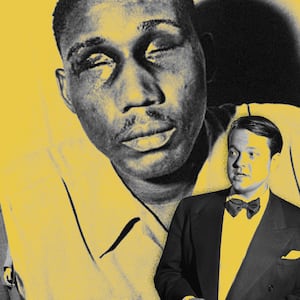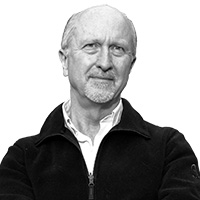Who was the South Carolina cop who beat a black U.S. Army veteran and crushed both his eyeballs in February 1946? As Richard Gergel writes in Unexampled Courage: The Blinding of Sgt. Isaac Woodard and the Awakening of President Harry S. Truman and Judge J. Waties Waring, Hollywood’s enfant terrible Orson Welles mounted a radio campaign to find out. In the first of his broadcasts, reading from Woodard's affidavit, Welles got some of the facts wrong. (The recording is at the end of this excerpt.) But over the next few weeks the error was corrected and the police chief who blinded Woodard was found.
[On] Sunday, August 25, an exuberant Welles opened his radio broadcast with these dramatic words: “This is Orson Welles speaking. The place was Batesburg. Isaac Woodard thought it happened in Aiken. He was wrong . . . The blame belongs . . . in Batesburg. Batesburg, South Carolina.” Welles then described the work of his investigators in locating a minister and several workmen who had observed the police chief of Batesburg and a highway patrolman pouring “buckets of water over the head and body of a soldier.” Welles reported the officers were “washing away” blood and between each pouring asking the soldier, “Can you see yet?” According to Welles, he simply responded no. That soldier was Isaac Woodard.
But Welles was not finished. He explained that when he brought the Woodard story to national attention, “the name of the guilty policeman was unknown and it looked as though it always would be. I promised to get that name, I have it now.” Welles then dramatically disclosed to his national audience the name of Woodard’s attacker:
“All clues led to Mr. L. L. Shull, chief of police in Batesburg, South Carolina. Now we have him. We won’t let him go. I promised I’d hunt him down. I have. I gave my word I’d see him unmasked. I’ve unmasked him. I’m going to haunt Police Chief Shull for all the rest of his natural life. Mr. Shull is not going to forget me. And what’s important, I’m not going to let you forget Mr. Shull.”
The public disclosure of Shull’s identity by Orson Welles on national radio generated widespread demands that Shull face criminal prosecution under federal civil rights laws. Welles received thousands of letters about the broadcasts and hundreds of requests for copies of his transcripts. Welles’s biographer Simon Callow described the Woodard radio broadcasts as the “single most effective political action of [Welles’s] life.”
The importance of identifying the officer responsible for Woodard’s beating and blinding is hard to overstate. In all other prominently reported incidents of racial violence then under investigation, a wall of silence was erected that made the prosecution of the perpetrators difficult. In the Woodard incident, the perpetrator was identified, and civil rights activists across the country demanded justice for the blinded veteran. The absence of any federal enforcement action in the other widely publicized racial crimes gave special force to the demand for action in the Woodard case.
As the Woodard incident emerged as a major national story, various organizations spontaneously stepped forward to promote and support the blinded veteran. Some groups undertook independent fund-raising efforts, and others invited Woodard to public meetings to share his story. The NAACP struggled to manage the situation, viewing Woodard and his story as under the organization’s exclusive control. But by this point, it was like trying to put lightning in a bottle as Woodard emerged as a living martyr for the cause of equal justice.
An event was organized in Harlem by C.B. Powell, a major black entrepreneur, as well as the NAACP and the Amsterdam News.
The public response was extraordinary. The entire twenty-three-thousand-seat stadium was sold out, and an estimated ten thousand people were turned away. The crowd roared approval as W. C. Handy’s orchestra performed “St. Louis Blues” and Cab Calloway performed “Hi-De-Ho.” In an original song, “The Blinding of Isaac Woodard,” Woody Guthrie sang, “I thought I fought on the islands to get rid of their kind, but I see the fight a lot plainer now that I am blind.” The audience response, Guthrie would later say, was the greatest he ever received as an entertainer. But the loudest applause of the evening was reserved for Woodard, who spoke to the crowd in a “faltering voice,” expressing his deep appreciation for the outpouring of support on his behalf. Woodard told the hushed audience that he wanted to see “that justice is done” regarding the police officer who had blinded him. Although not a skilled orator, he was a powerful, living symbol of racial injustice, a man who had devotedly served his country in wartime only to be blinded in the rural South because of the color of his skin. As one reporter observed, Woodard’s “simple speech . . . caused many to cry—people who have long been hardened to the ways of life, and the injustices heaped on a persecuted minority.”
The Woodard benefit concert was a resounding financial and community success. Over $10,000 was raised (approximately $130,000 in today’s dollars) for the blinded veteran, which allowed him to purchase a home. The benefit concert was trumpeted by the Amsterdam News as a “racial milestone” because the “entire affair was conceived, promoted and executed by Negroes” and reflected a united effort by the black community to “stop talking and do something.” In a column likely written by Powell, the community was urged to bring “the same singleness of treatment as characterized the effort to help Woodard” to attack the “torment and torture of lynching and violence in the South.”
A “National Emergency Committee” was formed to build on the publicity and the emotions surrounding the Woodard case.
The new organization established a smaller executive committee of major civil rights leaders with the objective of immediately setting up meetings with President Truman and Attorney General Clark to reengage the federal government as a protector of the rights of its African American citizens. In this effort, the National Emergency Committee sought nothing less than the reversal of the federal government’s role as a passive bystander to the denial of the constitutional rights of the nation’s black citizens. Although their efforts in the short term would meet with limited success, the civil rights leaders were about to trigger a series of actions and events, some anticipated and some not, that would forever transform American history.
Excerpted from UNEXAMPLED COURAGE: The Blinding of Sgt. Isaac Woodard and the Awakening of President Harry S. Truman and Judge J. Waties Waring by Richard Gergel. Published by Sarah Crichton Books, an imprint of Farrar, Straus and Giroux January 22nd 2019. Copyright © 2019 by Richard Gergel. All rights reserved.
Read it at

